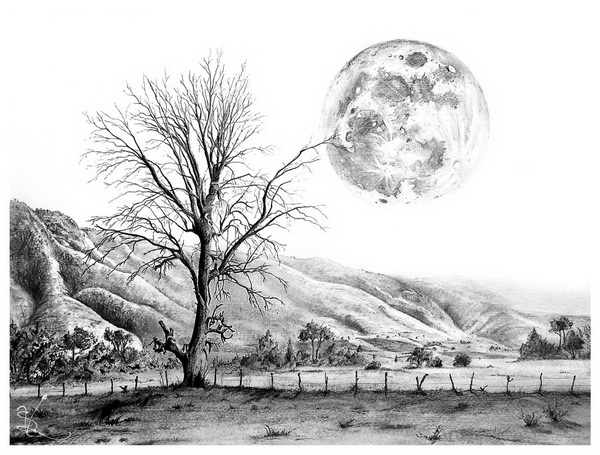

Try to identify those knots and kinks, and those bends in the branches. A common mistake is drawing the branches too straight.Drawing the correct proportions and angles of these points is what ‘creates’ the tree. This is what helps identifies the type of tree it is. This means the point of where every limb attaches to the trunk, every branch to limb and every twig to the branch. Pay particular attention to the ‘points of articulation’.The texture of the trunk is much more pronounced than on the branches as well. Also the bark of the tree will gradually get denser on the edges as it wraps itself around the tree. The shading should represent a cylindrical object. Here is a illustration of a tree branch dissected into cylindrical tubes. Trees are three-dimensional forms, cylindrical in nature that ‘branch” off into smaller cylinders. Here are a few trees that I have drawn. The level of detail depends how close the tree is in the scene. The texture of the tree trunk can vary greatly. After drawing these, I guarantee you won’t draw a straight line out of the ground to represent a tree again! Roots – What better way to understand the structure of a tree than to get to the root of the issue! These reference photos offer us an opportunity to draw some interesting and unique tree roots. ‘Feel’ those shadows go through your hand as you lay down that pencil stroke. The darker areas should have a heavier weighted line. Change and vary the weight of your pencil stroke to help develop depth in your tree.Be sure to put shadow at that base and draw the grass ‘around’ the trunk.Also the bark of the tree will gradually get more dense on the edges as it wraps itself around the tree. The shading should represent a cylindrical object.

TREE PENCIL SKETCH HOW TO
How to plant the tree firmly in the ground? I always pay particular attention to this step when drawing. So our first step is to get up close and personal…. You must feel the texture of the bark in your own hands, you must understand how each leaf attaches to the branches and the branches to the trunk. Here is my analogy - just as elbows, wrists, fingers, knees, ankles and toes are crucial to express the ‘flow’ of the human body – the joints (limbs, branches, twigs and roots) are crucial in expressing the ‘flow’ of the tree. It’s like trying to draw the human body without understanding about muscle, bones etc. It is so important to understand the substructure of a tree. What better way to learn how to draw trees than to get up close and personal!!ĭuring the past few years, I have spent a lot of time just observing and sketching trees. Also stroll through my galleries and pay particular attention to the trees and foliage.

I also have a tutorial on trees at There are additional samples that are not covered here. Why? Because he says it so much better than I do! Visit – Drawing Trees. Start where I began by reading Mike’s tutorial on trees! He covers material in his tutorial that I have purposely left out ofthis lesson.
The Smithsonian Handbook on Trees is beneficial in providing information on the general shapes and varieties of trees. Mike’s on-line tree tutorial was the foundation of my learning and understanding on how to draw trees. He dedicates an entire chapter just on drawing trees. Without a doubt, the most influential and important reference that I can recommend is Mike Sibley’s book “Drawing from Line to Life”. Focus on full-foliage trees such as oaks and maples.Learn tips and clues on how to draw trees.


 0 kommentar(er)
0 kommentar(er)
